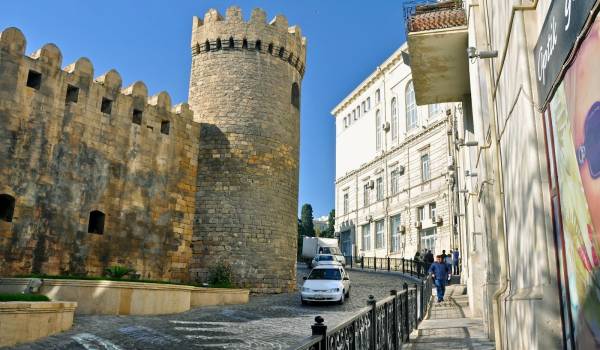
History of Baku
The history of Guba dating back to the early Middle Ages has been mentioned in ancient Albanian and Arabic sources, in various European geographical works. Thus, the first mosque that our Prophet built around Mecca is called Guba. The first stone of Guba was laid in the XIV century.
In the middle of the XVIII century, Guba was the center of the Guba khanate. During the rule of Huseynali khan's son Fatali khan (1758-1789) the position of the Guba khanate increased. Some historical monuments of that time, such as Chirag-Qala, exist till today. There is a cemetery in Guba, one of the worst genocide of the modern era, that took place there.
Guba Genocide Memorial Complex
The Memorial Complex is for the memorial of tens of thousands of Azerbaijanis who were killed in 1918 as a result of mass killings by the Bolshevik-Armenian armed groups on the Azerbaijani lands. The bloody tragedy that has entered the history of Azerbaijan as one of the most tragic genocides of the 20th century, Bolshevik-Armenian armed groups killed many people in Baku, Guba, Shamakhi, Goychay, Javad, Salyan, Karabakh, Zangazur, Nakhchivan, Lankaran, Ganja, and other regions, burned and destroyed more than villages. In April-May 1918, only 167 villages were completely destroyed only in Guba, the city was plundered and burned, and the Muslim and partially Jewish population was massacred. A massive cemetery was discovered accidentally in 2007 during construction work in Guba.
On December 30, 2009, President of the Republic of Azerbaijan Ilham Aliyev signed an order to create "Genocide" Memorial Complex in Guba with the aim of bringing Armenian nationalists territorial claims and aggression policies, bloody crimes against Azerbaijan to the attention of the international community, perpetuating the memory of genocide victims. The President of Azerbaijan Ilham Aliyev and his spouse Mehriban Aliyeva have opened the Guba Genocide Memorial Complex on September 18, 2013.
The architectural monuments like Agbil Tombs (XVI century), Subaba tomb in Alpan village (XVI century), mosque and minaret in the village of First Nugadi (XVII-XIX centuries), Taghli bridge(Gudyalchay bridge) over Gudyalchay river are protected. The village of Khinalig is the largest mountain village in Europe, there is the temple for fire-worshippers of the ninth century, the sixteenth-century tombs in the village of Agbil, the 19th-century Sakinakhanim, the Haji Jafar and Juma mosques, the Gumbazli bath. There is also an Alamu fortress and a historical mosque in the Rustov village.
Gilgilchay Castle
One of the largest, oldest, and noteworthy architectural sites in Guba is the wall of Gilgilchay Castle, built in the X-V-VI centuries by the Sassani dynasty. A strong fortress that stretches a few meters along the Gilgilchay River, descends into the Caspian Sea and rises to the mountains. The remnants of the wall, which have been preserved to this day, prove that it has a very effective fortification. The wall was 6 meters thick and 9 meters high. Inside the castle were found several remains of fortresses.
The tomb of Sheikh Junaid (16th century)
In the province of Guba, the village of Khazra (Holy) is located near the border of Azerbaijan with Dagestan. the Sheikh Junaid is a direct descendant of Sheikh Safi ad-din Yakub, the founder of the Safavid Iranian dynasty. Junaid's grandson built a magnificent tomb over Shah Tahmasib's grave. The walls of the mausoleum reach half a meter height and are covered with blue and black-and-violet glass tiles.
The mausoleum has a square configuration. The entrance is located on every four walls of the mausoleum. A dome stands in the center of the grave, 15 meters above the floor. The interior of the cemetery is remarkable with a quiet elegance. The tomb is still considered a sacred place among the people and hundreds of Muslims, pilgrims visit this place.
Juma Mosque
This mosque was built in the 19th century. Its construction is unique compared to other mosques. It looks like a cylinder with an ordinary octagonal shape. There is a 16m diameter large hall with a huge dome.
Chirag Castle
Near the high mountains, the ruins of Chirag-Kala Castle, the main point of the defense system of Gilgilchay Castle, are preserved. The north-east fortress walls are protected by a deep rock. The ruins of these towers are protected to this day. Towers were used to warn the danger ("Chrig-Kala" means "tower lamp"). At the tops of the towers, the fire was seen from a few kilometers away. The Chirag-Kala fortress was a kind of 'informant' and the largest alert system among other medieval towers. The path to the Chirag Castle is quite long: It is advisable to be prepared beforehand for the journey to the castle as it's taking much time.
Red settlement
Fatali khan, the most famous of the rulers of the Guba khanate, tried to unite all khanates of Azerbaijan under his leadership. He subdued all northeastern Azerbaijan from Derbent to Lankaran. At that time, the Jews were invited to settle in Guba, on the left bank of the Kudyalchai. This settlement, formerly called the Jewish Slobodas, has been called the Red Settlement since 1926. The Red Town is a very famous Jewish village with two active synagogues, including the Great Synagogue. Its convenient existence is often proved as evidence of Azerbaijan's religious tolerance.